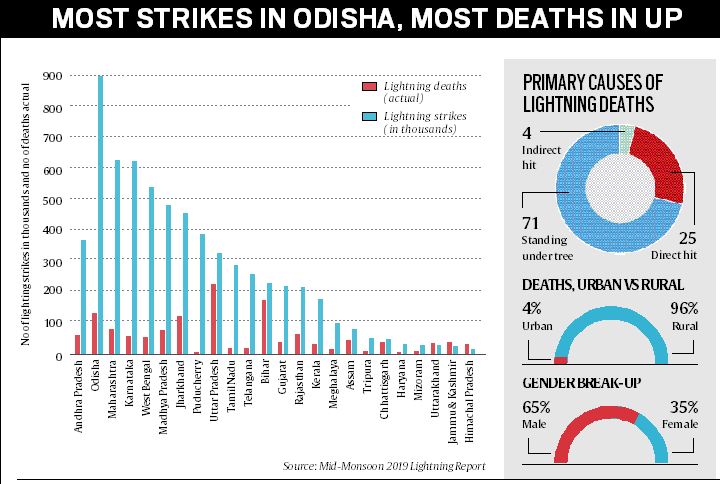A report on “lightning incidents in India” – Key Findings 16/09/2019 – Posted in: Daily News – Tags: How does a lightning strike Earth?
LIGHTNING ACROSS INDIA
For: Mains
Topics covered:
- Mapping lightning across India: Key Findings
- How is lightning formed?
- How does a lightning strike Earth?
News Flash
A report on “lightning incidents in India” has been prepared and presented by Climate Resilient Observing Systems Promotion Council (CROPC), which works closely with the India Meteorological Department (IMD).
- For the first time, a report has mapped lightning strikes across the country, and the lives they have claimed.
- Uttar Pradesh accounted for 224 of these deaths, followed by Bihar (170), Odisha (129) and Jharkhand (118).
Key findings
- It counted 65.55 lakh lightning strikes in India during the four-month period between April and July this year.
- Out of which, 23.53 lakh (36 percent) happened to be cloud-to-ground lightning, the kind that reaches the Earth.
- The other 41.04 lakh (64 percent) were in-cloud lightning, which remains confined to the clouds in which it was formed.
- Odisha recorded over 9 lakh incidents of lightning (both kinds).
- Between 2,000 and 2,500 people are estimated as killed every year in lightning strikes in the country.
- Thousands of thunderstorms occur over India every year. One thunderstorm can involve more than 100 lightning strikes.
Importance of these findings
- This report may help in creating a database that can help develop an early warning system for lightning, spread awareness, and prevent deaths.
- It is possible to predict, 30-40 minutes in advance when a lightning strike heads towards Earth.
- The prediction is made possible through the study and monitoring of the in-cloud lightning strikes. Timely dissemination of this information can save several lives.
How is lightning formed?
- Lightning is a very rapid and massive discharge of electricity in the atmosphere. It is a result of the difference in electrical charge between the top and bottom of a cloud.
- The lightning-generating clouds are typically about 10-12 km in height, with their base about 1-2 km from the Earth’s surface.
Process
- As water vapour moves upwards in the cloud, it condenses into water due to decreasing temperatures.
- A huge amount of heat is generated in the process, pushing the water molecules further up. As they move to temperatures below zero, droplets change into small ice crystals.
- As they continue upwards, they gather mass, until they become so heavy that they start descending.
- It leads to a system where smaller ice crystals move upwards while larger ones come down. The resulting collisions trigger the release of electrons, in a process very similar to the generation of electric sparks.
- The moving free electrons cause more collisions and more electrons; a chain reaction is formed.
- The process results in a situation in which the top layer of the cloud gets positively charged while the middle layer is negatively charged. The electrical potential difference between the two layers is huge, of the order of billions of volts.
- In little time, a huge current, of the order of lakhs to millions of amperes, starts to flow between the layers.
- It produces heat, leading to the heating of the air column between the two layers of the cloud. It is because of this heat that the air column looks red during lightning.
- The heated air column expands and produces shock waves that result in thunder sounds.
How does a lightning strike Earth?
- The Earth is a good conductor of electricity. While electrically neutral, it is relatively positively charged compared to the middle layer of the cloud.
- As a result, an estimated 20-25 per cent of the current flow gets directed towards the Earth.
Source: Indian Express
READ MORE DAILY NEWS
- Centralised Technology Vertical
- A new study on Human Trafficking in India
- Travel and Tourism Competitive Report
- Asteroid Impact & Deflection Assessment (AIDA) mission
- Indian Gold Reserve
- Reducing Food Loss and Waste: Report
You are on the Best Online IAS preparation platform. You are learning under experts.
We are present on Facebook- Diligent IAS, LinkedIn- Diligent IAS, YouTube- Diligent IAS, Instagram- Diligent IAS. Get in touch with us.

